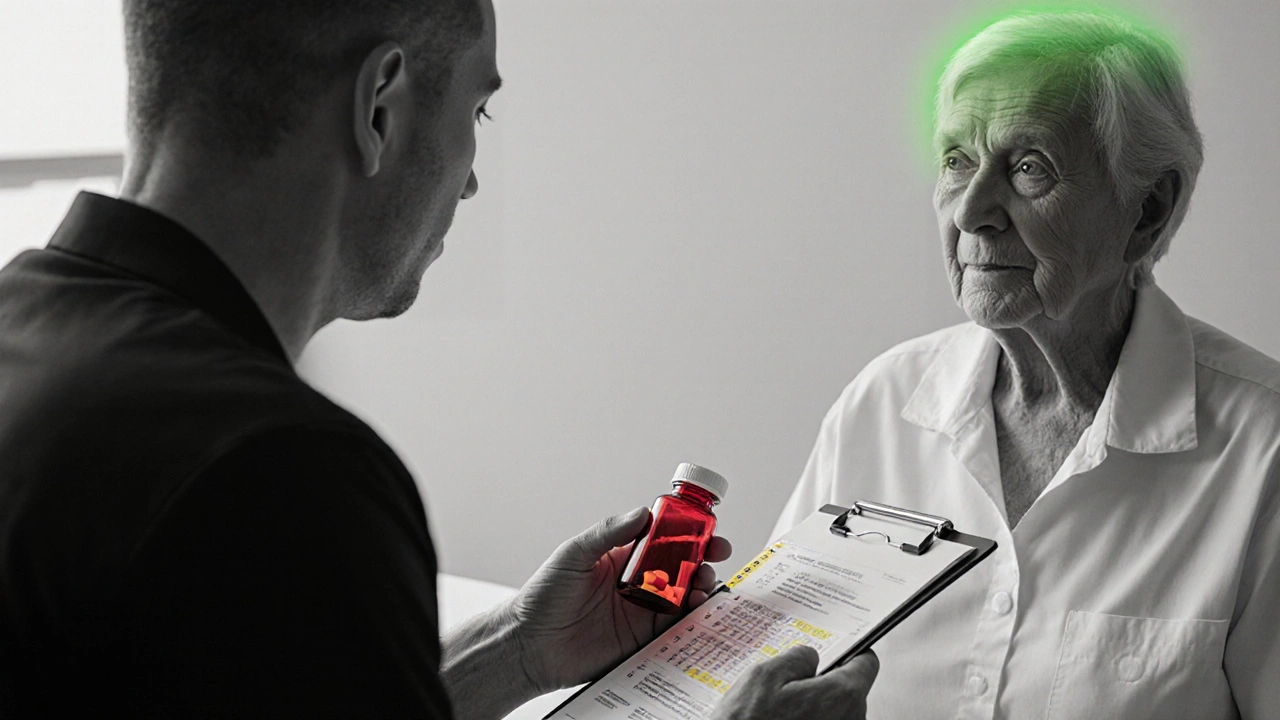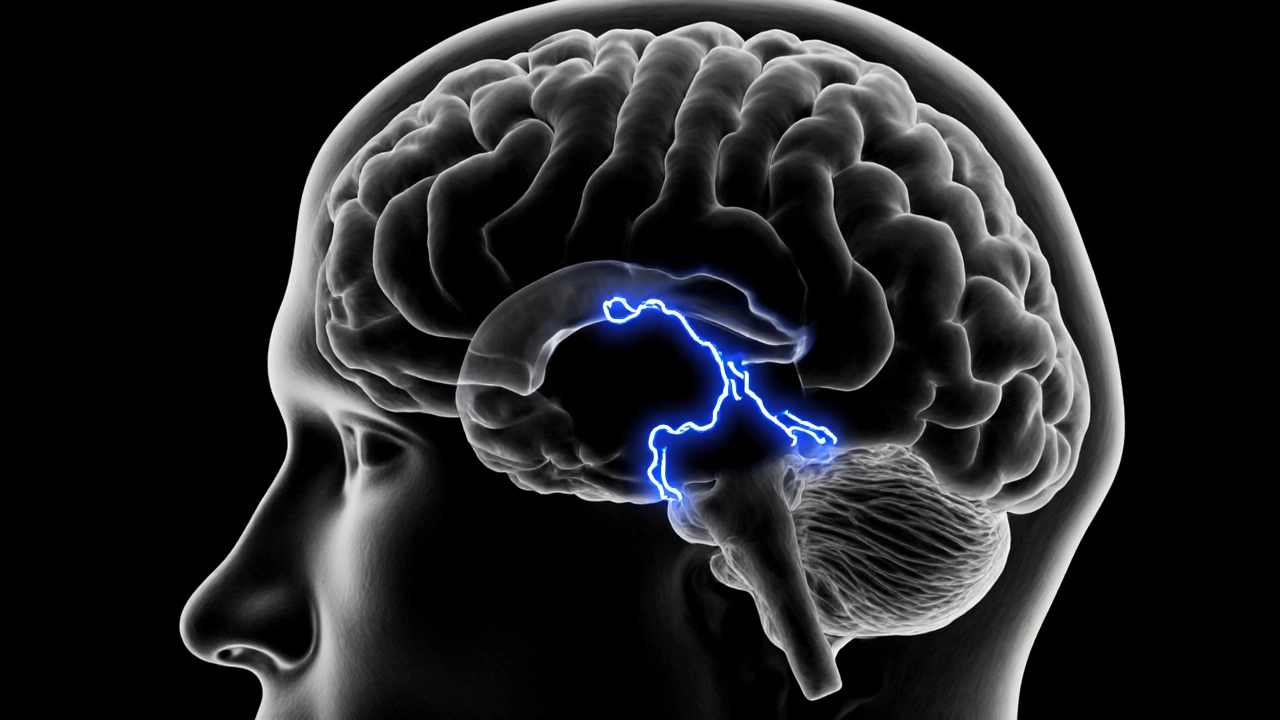Carbidopa-Levodopa Dose Adjustment Calculator
Patient Assessment
Recommended Dosing Plan
Key Monitoring Points
Monitor for hallucinations within 4-7 days of dose increase
Take with low-protein meals to maximize absorption
Re-evaluate cognitive status every 3 months using MoCA
When managing Parkinson’s disease‑related dementia, Carbidopa‑Levodopa is a combination medication that delivers the dopamine precursor levodopa while preventing its premature conversion in the periphery via the decarboxylase inhibitor carbidopa remains the cornerstone therapy for motor symptoms.
Understanding Parkinson’s Disease‑Related Dementia
Parkinson’s disease is a progressive neurodegenerative disorder characterized by loss of dopaminergic neurons in the substantia nigra, leading to tremor, rigidity, and bradykinesia. About 30‑40% of people with Parkinson’s develop dementia as the disease advances, a condition often called Parkinson’s disease‑related dementia (PDD) a cognitive decline that co‑exists with the classic motor features. The hallmark cognitive changes include impaired executive function, slowed thinking, and visual‑spatial deficits.
How Carbidopa‑Levodopa Works
The therapeutic effect hinges on two components:
- Levodopa is the metabolic precursor of dopamine that crosses the blood‑brain barrier and is converted to dopamine in the brain.
- Carbidopa is a peripheral dopa‑decarboxylase inhibitor that blocks the conversion of levodopa to dopamine outside the brain, allowing more levodopa to reach central targets and reducing peripheral side effects.
The combination increases striatal dopamine, improving motor function. Because dopamine also modulates front‑striatal circuits involved in cognition, clinicians have long wondered whether the drug can influence the dementia component as well.
Evidence for Cognitive Benefits
Randomized controlled trials (RCTs) and observational studies over the past decade provide a nuanced picture:
- Short‑term (≤12 weeks) trials of optimized Carbidopa‑Levodopa doses often show modest improvements in attention and working memory, measured by the Stroop and Trail Making tests.
- Long‑term cohort studies (2-5 years) indicate that patients maintaining stable levodopa therapy have a slower rate of cognitive decline compared with those experiencing frequent motor fluctuations.
- Neuroimaging studies reveal increased activation in the prefrontal cortex after levodopa administration, suggesting a direct neurophysiological effect on cognition.
However, benefits are not uniform. Patients with prominent cholinergic deficits-common in advanced PDD-may see limited cognitive gain, emphasizing the need for adjunctive strategies.

Risks and Side Effects Specific to Dementia Patients
While Carbidopa‑Levodopa is generally well‑tolerated, certain adverse events deserve special attention in the dementia population:
- Neuropsychiatric issues: Hallucinations, delusions, and impulse‑control disorders can emerge, especially at higher doses.
- Orthostatic hypotension may exacerbate falls, a major concern for cognitively impaired patients.
- Vomiting and nausea are reduced by carbidopa, but can still occur if dosing is rapid.
Clinicians should start low, titrate slowly, and monitor neuropsychiatric symptoms closely.
Practical Guidelines for Clinicians
The following checklist helps integrate Carbidopa‑Levodopa into a PDD treatment plan:
- Baseline assessment: Document motor severity (MDS‑UPDRS Part III) and cognitive status (MoCA or MMSE).
- Start low: Initiate with ¼ tablet (e.g., 25/100mg) three times daily.
- Titrate gradually: Increase by ¼ tablet every 4-7 days until motor goals are met, while watching for hallucinations.
- Maintain consistent timing: Align doses with meals low in protein to enhance absorption.
- Re‑evaluate every 3 months: Adjust based on motor fluctuations, cognitive testing, and side‑effect profile.
- Consider adjuncts: Add a cholinesterase inhibitor if memory deficits dominate, or an MAO‑B inhibitor for additional motor control.
The most common prescription for Parkinson’s symptoms is Carbidopa-Levodopa, but the above steps help balance motor benefit against cognitive risk.

Alternative and Adjunctive Therapies
When Carbidopa‑Levodopa alone does not control symptoms or provokes psychiatric side effects, several options exist:
| Therapy | Primary Target | Typical Benefit | Key Risks |
|---|---|---|---|
| Carbidopa‑Levodopa | Dopamine | Improves gait, rigidity, and may modestly aid attention | Hallucinations, dyskinesia, orthostatic hypotension |
| MAO‑B inhibitors (e.g., selegiline, rasagiline) | Dopamine metabolism | Reduces OFF time, smoother motor control | Hypertensive crisis with tyramine, insomnia |
| Cholinesterase inhibitors (e.g., rivastigmine) | Acetylcholine | Improves memory, executive function | Nausea, weight loss, bradycardia |
| Deep Brain Stimulation | Subthalamic nucleus or globus pallidus internus | Reduces motor fluctuations, may lower medication dose | Surgical risks, infection, mood changes |
Choosing the right mix requires evaluating the patient’s dominant symptoms, comorbidities, and personal preferences.
Key Takeaways for Caregivers
- Carbidopa‑Levodopa can help motor symptoms and, in some cases, modestly improve attention.
- Watch closely for new or worsening hallucinations; report them promptly.
- Adherence to a regular dosing schedule maximizes benefit.
- Complementary drugs or DBS may be needed when side effects limit levodopa use.
Frequently Asked Questions
Can Carbidopa‑Levodopa reverse dementia in Parkinson’s?
No. The drug primarily targets dopamine deficiency and can improve attention and executive function modestly, but it does not cure or reverse the underlying neurodegeneration that causes dementia.
What dose is considered low enough to avoid hallucinations?
Starting with 25mg/100mg of Carbidopa‑Levodopa three times daily and increasing by 25mg/100mg every week is a commonly used low‑titration strategy. Individual tolerance varies, so monitor closely.
Should I combine Carbidopa‑Levodopa with a cholinesterase inhibitor?
Yes, many clinicians add rivastigmine or donepezil when memory and executive deficits dominate. The combination is generally safe, but watch for nausea from both drugs.
Is Deep Brain Stimulation an alternative to Carbidopa‑Levodopa for dementia patients?
DBS can reduce motor fluctuations and may allow lower levodopa doses, which can lessen psychiatric side effects. However, surgical risks increase in older patients with significant cognitive impairment, so careful selection is essential.
How often should cognitive status be reassessed while on Carbidopa‑Levodopa?
Every 3-6 months is recommended, using tools like the Montreal Cognitive Assessment (MoCA). Adjust therapy promptly if a decline is noted.






Balancing motor improvement with cognitive preservation is truly a delicate art in Parkinson’s disease‑related dementia. While levodopa certainly restores dopaminergic tone, the downstream effect on front‑striatal circuits can be modestly beneficial for attention. However, the clinician must weigh these gains against the potential for neuropsychiatric side‑effects, especially in patients already vulnerable to hallucinations. A low‑and‑slow titration, paired with regular cognitive reassessment, often yields the best compromise. Moreover, integrating cholinesterase inhibitors when cholinergic deficits dominate can further smooth the cognitive landscape. Ultimately, a patient‑centered approach that respects both motor and mental health seems most prudent.
October 16Yassin Hammachi